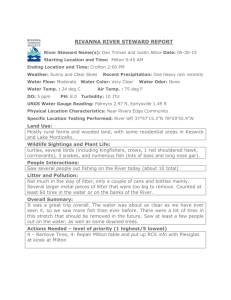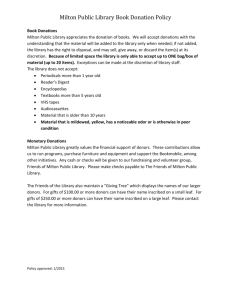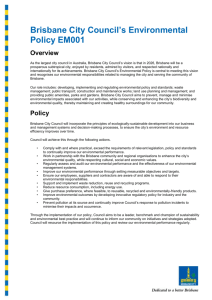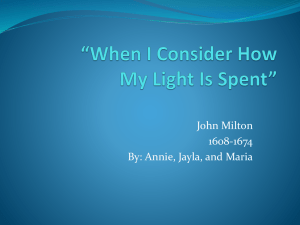Brisbane Heritage Trails - Meander Through
advertisement
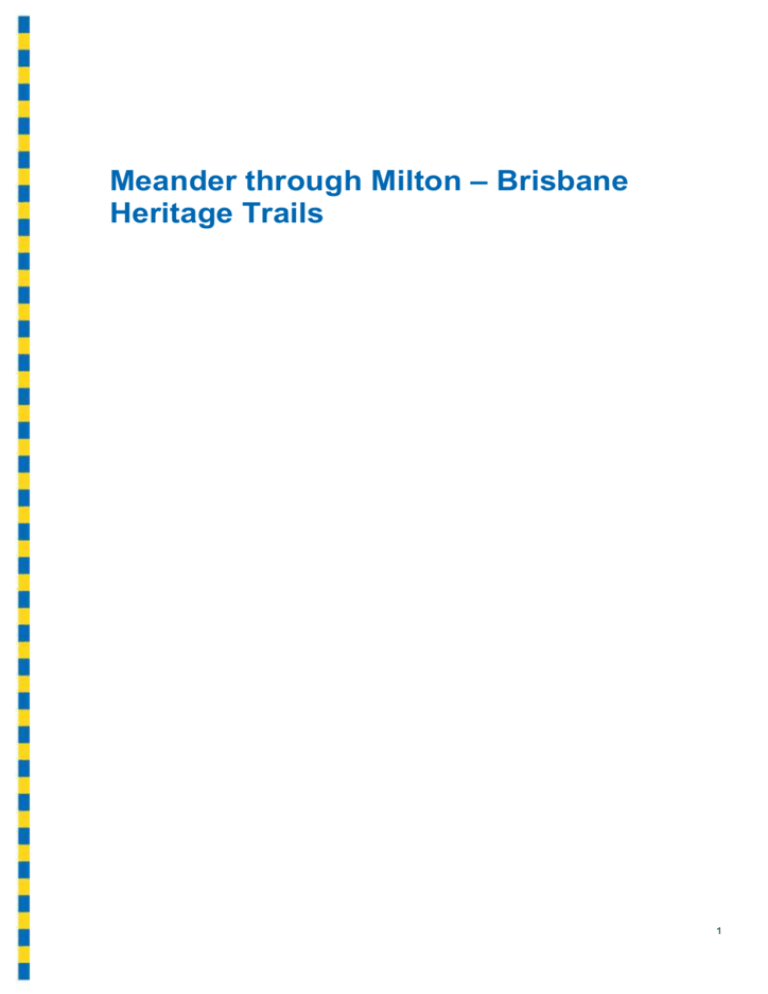
Meander through Milton – Brisbane Heritage Trails 1 Contents Meander through Milton – Brisbane Heritage Trails ...................................................................... 1 Map ............................................................................................ Error! Bookmark not defined. Introduction ............................................................................................................................... 3 1. Smith’s Shop ......................................................................................................................... 4 2. ‘Savoir Faire’ ......................................................................................................................... 4 3. Milton House ......................................................................................................................... 5 4. Salvation Army Rescue Home ............................................................................................... 5 5. John Oxley ............................................................................................................................ 5 6. Cook Terrace ........................................................................................................................ 6 7. Milton and floods ................................................................................................................... 6 8. Coronation Motel ................................................................................................................... 7 9. John Hicks Ltd ....................................................................................................................... 7 10. Cribb Street terrace houses ................................................................................................. 7 11. Milton Sanitary Disposal Depot ............................................................................................ 8 12. Milton Tramway Workshops ................................................................................................ 8 13. Milton’s industry................................................................................................................... 9 14. Lang Park and Christ Church Anglican Church.................................................................... 9 15. World War II air raid shelter ............................................................................................... 10 16. XXXX factory ..................................................................................................................... 10 17. ‘Bishopsbourne’ ................................................................................................................. 11 2 Introduction The reach of the river known today as Milton was one of the preferred sites identified in 1824 by John Oxley, Surveyor-General of New South Wales (NSW), as a suitable place to establish a settlement due to the fresh-water creek (Western Creek) and the abundance of timber. The Moreton Bay convict settlement was first established at Redcliffe in 1824, but was not successful and was moved to the present Central Business District (CBD) in 1825. The convict settlement was closed in 1839 and in 1842 Moreton Bay was officially opened for free settlement as part of the colony of New South Wales. In 1843 the North Brisbane Burial Grounds were situated on the northern boundary of Milton where Suncorp Stadium now stands. This was the main cemetery for the fledgling town. The cemetery was closed in 1874 and eventually became sporting grounds in the early 20th Century. By the 1850s the land along the Milton reach of the river was cleared and farms established. The Aboriginal people in the area became increasingly displaced by the European presence and were forced to move further away from the settlement. The first major European landowners in the area were Ambrose Eldridge and Robert Cribb. They built substantial houses on large estates in the 1850s, ‘Milton House’ and ‘Dunmore’. In 1875 the rail line to Ipswich was opened and a station built at Milton. This encouraged residential settlement in Milton and by the 1880s the large estates and much of the surrounding land had been subdivided into small residential lots. As the population of Brisbane expanded in this era, so too did Milton’s. The small pocket of land between Milton Road and the river soon became filled with workers’ cottages, small businesses and industry. The brewery on Milton Road was established in the 1870s and provided many local jobs. Other industries also moved into Milton in the late 19th and early 20th Centuries including a sawmill, brick works, biscuit factory, furniture workshop and tram workshop. In 1889 a school was opened in the now adjacent locality of Rosalie and became known as the Milton State School. 3 The Queensland Lawn Tennis Association (QLTA) was formed in 1888, but it wasn’t until 1915 that they found a permanent home with the acquisition of land at Milton. After World War II the Milton Tennis Centre was recognised at an international level. When it closed in 1998, it had been host to more Davis Cup matches than any other city in Australia. In 1904 electric trams began running down Milton Road. During the inter-war period, Milton’s population continued to expand and so too did its industry. Coronation Drive was originally called River Road. In 1937 the name was changed to commemorate the Coronation of George VI in the same year. In 1988 Park Road was transformed into Brisbane’s first alfresco dining precinct and continues to be one of Brisbane’s premier restaurant hubs. 1. Smith’s Shop The timber building, known as Smith’s Shop, was constructed in 1888 and is a good example of a 19th Century shop and residence in Milton. It was built by Thomas Smith and his wife, Agnes. Mr Smith worked as a horse-drawn cab proprietor and Mrs Smith was a milliner and dressmaker. The shop downstairs had several tenancies throughout its history including a grocer and a confectionery shop. Unlike today, Park Road in the late 19th Century was a mix of houses and small shops. There was a general store, a butcher, a bootmaker and a dressmaker. Several of the houses had names including ‘Heywood’, ’Valetta’, ‘Woodlands’ and ‘Enoggera’. In 1932 there were 30 houses and three shops. Today, Park Road has been transformed into a commercial, retail and entertainment precinct. 2. ‘Savoir Faire’ ‘Savoir Faire’ is Brisbane’s first alfresco dining precinct and was opened in 1988, the same year Brisbane hosted the World Exposition, Expo ’88. With its imitation Eiffel Tower, faux cobblestone pavements and rattan footpath chairs, the Park Road restaurant and shopping precinct attempted to bring a little bit of European style to Brisbane and started a trend that remains today. The success of ‘Savoir Faire’ was undoubtedly influenced by the impact Expo ’88 had on Brisbane residents. Many believe that it was Brisbane’s ‘coming of age’, as the city experienced different cultures, food, lifestyle and entertainment. The Courier-Mail described Expo as “bridging the yawning gap from a hayseed State to an urbane, international future” (The Courier-Mail, April 1988). The number of visitors over the six months exceeded 15.7 million. Expo ’88 was opened on 30 April 1988. Fifty-five international participants, including 36 nations were represented. Large, temporary pavilions showcased each country’s display. The site chosen for the exposition was the old industrial and wharf precinct in South Brisbane. Expo ’88 was open every day for six months between 10am-10pm. Street performers, day and night parades, daily fireworks and laser shows set to music, rock concerts, street art, the monorail, an amusement park and aquacade were all added attractions. Brisbane residents who fondly remember Expo ‘88 tell of the exciting ‘vibe’ and carnival atmosphere – as well as the amazing array of international foods. ‘Savoir Faire’ continued to provide Brisbane residents with a vibrant restaurant and shopping precinct well after Expo ’88 had ended. The only original café remaining, ‘La Dolce Vita’, is still one of Brisbane’s favourites. 4 3. Milton House Milton House is one of the oldest houses in Brisbane. In 1851 Ambrose Eldridge, a chemist in Queen Street, purchased 30 acres of land fronting the Brisbane River. It was his intention to establish sustainable agriculture in the Moreton Bay district that would yield a profit. On his farm, now known as Milton, he began to experiment with cotton growing. As one of Great Britain’s main imports at the time, Eldridge believed that if a cotton industry could be successfully established in Moreton Bay, it would secure a future for the settlement. In 1852 Eldridge retired from his chemist business to concentrate on his agricultural pursuits. It was around this time he built his beautiful house situated on the peak of a hill and surrounded by cleared farmland. It could easily be seen from the city and from the river. Eldridge’s cotton crops were initially very successful – they won a NSW agricultural award and were highly commended at the 1855 Paris Exhibition. He decided to move his farming pursuits to Eagle Farm and sold the Milton Estate in 1856 to successful Darling Downs pastoralist, John Frederick McDougall. Unfortunately for Eldridge this was not a success, and by 1859 he had been forced to return to his former occupation. He died penniless in 1860. It is unclear when the house was named ‘Milton House’. Some suggest it was named by Eldridge after the poet John Milton, others believe it was named by McDougall after his birthplace in England, Greater Milton. Regardless, its importance to the local district is demonstrated by many of the streets around Milton being named after former residents of the house including J.F. McDougall, Colonial Under-Secretary, Arthur Manning and politicians William Henry Walsh and James Crombie. Today, the house has been restored by its current owner, the Kings Row Corporation, as part of their new development surrounding the historic house. 4. Salvation Army Rescue Home The Salvation Army Rescue Home was set up in 1888 in a two-storey timber cottage. Its purpose was to provide shelter and protection, both physical and moral, to women who had fallen into prostitution, crime, drug or alcohol addiction. It also helped single pregnant girls who were destitute. At a time when there was a deep sense of shame associated with these situations and no government welfare, women who were disowned by their families and found themselves completely alone, often relied on the help of the Salvation Army and other similar organisations. The home was run by female Salvation Army members known as the ‘Rescue Sisters’, dedicated to helping women and their children. In 1890 the Park Road home was described as being “pleasantly situated just off the bank of the river… there is nothing in the appearance of its lacecurtained windows, or its aspect of general homeliness, to give the passer-by any clue to the labours of love and mercy which are carried on inside” (The Queenslander, 12 July 1890). Much of the funding for the home came from public donations. An average of 24 ‘cases’ could be accommodated in the home. Often this number was exceeded and extra beds would need to be made up on the floor. Women who sought shelter were given medical assistance, including midwifery services for the birth of their babies. They were given practical training in domestic skills such as cooking, sewing and laundry as well as spiritual guidance. The Army’s aim was to enable these women to find work in domestic service and steer them away from returning to the perilous situations that they had escaped. The home moved from Park Road to larger premises in Taringa in 1894. 5. John Oxley In 1825, after a failed attempt at settlement at Redcliffe, the Moreton Bay convict colony was moved to the current site of Brisbane’s CBD. Prior to this, in 1823, Surveyor-General, John Oxley had been directed by the Governor of New South Wales, Sir Thomas Makdougall Brisbane, to find suitable sites for a new settlement to send wayward convicts. Following advice about the location of a large river from John Finnegan, a ticket-of-leave man who had been stranded in the 5 area, Oxley entered Moreton Bay on 29 November 1823. He named the river ‘Brisbane’. The Milton Reach of the river was described on his 1823 map as having “rich flats and fine timber”. Approximately one year later, Oxley led another expedition up the Brisbane River to identify possible settlement sites. He noted only a few along the river believed to have the potential to sustain a settlement. According to Oxley’s journal, the expedition set up camp one night along the river, “there being a small creek” (John Oxley, Monday 27 September 1824). The location of this is thought to have been somewhere near the present Regatta Hotel. The next morning, after further exploration of the area, Oxley discovered a series of large fresh-water ponds linked by a creek; “the soil good, with timber and a few pines, by no means an ineligible station for a first settlement up the river” (John Oxley, Tuesday 28 September 1824). It is believed that this was Western Creek. 6. Cook Terrace Cook Terrace was built between 1888-1889 and is one of Brisbane’s few remaining blocks of terrace houses. They were constructed as rental properties by Joseph Blain Cook. Prior to their construction, the Queensland Government introduced the Undue Subdivision of Land Prevention Act 1885. There were concerns with over-population in inner-city areas from as early as the 1870s. The construction of small tenements and tiny cottages on very small parcels of land increased the risk of disease and fire throughout the inner-city suburbs. With the passing of the 1885 legislation it became illegal to subdivide land into lots of less than 16 perches (405m²). It was also illegal to grant title of ownership to individual terrace houses. It was believed that this too would lead to overcrowded and unhealthy living conditions and so the terraces remained rental properties. After 1885 it became unusual for this style of terrace housing to be constructed in Queensland. The terraces became a prestigious riverfront address and were home to primarily professional tenants. For example, in 1891 there was a barrister, a builder, the Acting Secretary of the Queensland National Bank, a merchant and important Queensland politician and Colonial Secretary, The Honourable H. Tozer, Member of Legislative Assembly (MLA). By the 1920s a tennis court had been built on the corner of Park Road and Coronation Drive (then River Road). After World War II, the terrace houses were registered as flats for 73 persons and this heralded an era of decline. Thankfully, in the 1980s they were restored and are now used as commercial premises. 7. Milton and floods From 12-14 January 2011, Brisbane experienced a major flood, the most severe for 37 years. Heavy rains over much of the state and in particular the Lockyer Valley west of Brisbane had caused the Brisbane River to break its banks. Approximately 20,000 homes experienced some level of flooding in Brisbane. Milton was one of the worst affected areas with most of the suburb inundated by flood waters including the XXXX factory and Suncorp Stadium. With its location beside the river and bounded by Western Creek, Milton has always been susceptible to flooding. In February 1893, Brisbane suffered its worst recorded flood event. Torrential rain from three successive cyclones that crossed the central Queensland coast caused the banks of the river to burst three times. The first and third flood events caused the most damage; “The flood of 1893 has been a drama in three acts, and however unwelcome the presentation we must acknowledge that Dame Nature has made her exploits the topic of the hour” (The Brisbane Courier, 20 February 1893). Many people living in Milton lost everything when the first flood hit on 4 February 1893 and were forced to endure more devastation when the next two flood events swept through on 13 and 19 February. It was reported that “very few houses in the Milton district were out of water during the flood… as the waters rose the people fled, and at one time there must have been fully 600 people standing on the eminences with the waters rising on every hand” (The Queenslander, 6 11 February 1893). Thirty-five people were believed to have died in the 1893 floods – three were from Milton. 8. Coronation Motel In 1964, Associated Motels Pty Ltd purchased a large portion of the former John Hicks Ltd site and built the Coronation Motel. The motel was designed by local architectural firm Chiverrell and Rubis and was the tallest building in the Milton precinct for many years. When first opened it was one of the most fashionable venues in Brisbane and was the first motel to be issued with a residential liquor licence in 1970. Motels first appeared in the United States of America in the 1920s. These ‘motor hotels’ were established at a time when motor car ownership was increasing and allowed for an ease of mobility unseen in earlier times. Motels offered a room with a bed and bathroom facilities. They also provided a space to park the car. In post-war America and Australia, car sales rapidly increased as the economy stabilised and cars became more affordable. In the 1950s and 1960s many motels were established throughout America and as with many trends that come out of the US, Australia quickly adopted it. The Coronation Motel provided its guests with very modern facilities for the time including underground car parking, restaurant, bar, dance venue, pool and river views. It was close to the city and an alternative to the inner-city hotels. It became one of Brisbane’s premier hospitality venues and when it finally closed could boast a long list of international celebrity guests – from Luciano Pavarotti to Boy George. The motel was demolished in 2002. 9. John Hicks Ltd In 1911 construction work began on a large furniture factory on the corner of Cribb Street and River Road (now Coronation Drive). The site was just more than an acre and owned by successful businessman, John Hicks, whose showrooms on the corner of George and Ann Streets in the city provided Brisbane residents with fine furniture, much of which was made from Queensland timbers. The Milton factory was so large that it took up more than half the site. John Hicks arrived in Brisbane in the 1860s and set up his own furniture business in Albert Street in the city. By the 1870s he had moved his business to a larger site in Roma Street and then to a new building on George Street in 1888. Initially, much of the furniture was made in a workshop at the George Street store but by 1911 the business was so successful that a much larger workshop was required. The company, also known as ‘Hixco’, became renowned for high-quality, locally-produced furniture; “the beauty and quality of which could scarcely be exceeded in any part of the world, for the best workmen and the best materials only are employed” (The Brisbane Courier, 2 December 1909). From about 1890, John Hicks lived in a large house beside the site where the factory was eventually built called ’Bunya Bunya’. In the early hours of 2 February 1893 a massive fire destroyed this house. The Queensland Times reported that “great as the loss of the house is to Mr Hicks, he will probably feel the loss of his furniture and contents even more keenly, for it is well known that his residence was furnished on a scale unsurpassed by few house-holders in Brisbane” (Queensland Times, 2 February 1893). No one was hurt in the blaze. Another large house had been built on the site by the late 1890s called ‘Cooreel-Ba’. In the 1920s, this house was converted into four flats and named ‘Sandringham Place’. It too was destroyed by fire in 1929. Once again, no one was hurt in the fire. 10. Cribb Street terrace houses Along Cribb Street between 1887-1890, two sets of Victorian terrace houses were built on the left side of the street from the river end. The first set was constructed in 1887-1888 and consisted 7 of eight attached houses between McDougall Street and Railway Terrace. Each house was made of brick and consisted of “four main rooms, half hall, kitchen, two verandah rooms, pantry, washhouse, and stables” (The Brisbane Courier, 17 March 1920). Each had its own bay window fronting the street and the stable in the backyard was accessed from Crombie Street. Instead of the set being given one name, all but one had its own: ‘Mimi’, ‘Idaville’, ‘Rosella’, ‘Camara’, ‘Strathearne’, ‘Glengeary’ and ‘Barcoo’. In the 1960s they were demolished and replaced with industrial buildings. The second set of terraces was built in 1889 and was called ‘Hobart Terrace’. It consisted of four, three-storey brick houses with front verandahs and was situated between River Road (now Coronation Drive) and McDougall Street. These houses had smaller backyards and no stables. They were also demolished in the 1960s. During the 1893 floods, both sets of terraces were inundated by water. In this photograph, the rear of ‘Hobart Terrace’ can be seen behind the pyramid roofs of submerged houses. The water was well above the first floor level. 11. Milton Sanitary Disposal Depot This site was first used for the Milton Distillery, which began operations in 1871. The distillery produced rum and was one of Milton’s first industries. It was closed in 1900. The area between Park Road, the railway, Cribb Street and Coronation Drive was first known as the ‘Milton Estate’. It consisted mainly of 16-perch blocks (405m²) each containing a small workers’ cottage. By the 1890s, there were approximately 100 houses within this pocket. It was predominately a working-class area and most families were fairly poor. Before Brisbane homes had flushing toilets and an efficient sewerage system, waste from backyard toilets was collected by the night soil man. Sanitary problems arose in this part of Milton when almost half of the households were burying their night soil in their backyards as they couldn’t afford the services of the night soil man. Whenever there was a large downpour of rain the low-lying areas became a swamp of waste escaping from many of the backyards. By the early 20th Century Milton Sanitary Disposal Depot had been established to address Milton’s sanitary problems. Initially, the facility was a rubbish dump with a massive chimney (approximately 40 metres high) attached to a large incinerator where 75% of Brisbane’s rubbish was burnt. By the 1920s, the Milton facility was also used as a disposal depot for night soil. Before this, the night soil man delivered the waste to a steamer docked at North Quay. It would then be taken out into Moreton Bay and dumped at sea. Once set up, night soil from all over the district was taken by cart to the Milton Depot where it was placed into the sewerage system and pumped out to Pinkenba. During the years of its operation, Milton residents lobbied for the depot to be moved elsewhere and by 1949 it was closed. 12. Milton Tramway Workshops From 1904, electric trams ran along Milton Road through to Toowong and provided Milton residents with an alternative public transport option to trains or horse-drawn omnibuses. In 1930, the tramway workshops were moved from Countess Street to a larger site on low-lying land on Boomerang Street. Initially the site comprised of workshops, car sheds and administrative offices. During World War II, the workshops contributed to the war effort in several ways. Initially, they began to manufacture sprocket wheels for tanks; “the sprocket wheels are made by slicing locomotive wheels, a task which requires accuracy to the thousandth part of an inch” (The Courier Mail, 23 June 1941). As the war escalated with the bombing of Pearl Harbour on 7 December 1941 and America’s declaration of war on Japan, Brisbane became the headquarters for the US-led, Allied South West Pacific Campaign under US General Douglas MacArthur. At its height, Brisbane was host to more than 75,000 US troops awaiting deployment to the Pacific. The threat of Japanese air raids over Brisbane was a major concern. 8 An intensive defence system consisting of gun emplacements and searchlights was spread across Brisbane. To bluff enemy aerial reconnaissance, a series of ‘dummy’ wooden guns were also placed at strategic points throughout Brisbane to give the impression that the city was well defended. These mock-ups were manufactured at the Milton Tramway Workshops. They were made to look as realistic as possible and were painted in the army colours. The workshops expanded in the 1950s into the site that was formerly used for the Milton Sanitary Disposal Depot and continued to dominate this low-lying part of Milton for many years. By the 1960s, when compared with buses, Brisbane City Council viewed trams as an inefficient, expensive and inflexible form of public transport and subsequently decided to discontinue the service across Brisbane. On Sunday 13 April 1969, the last Brisbane tram passed along Queen Street on its final run to the workshops at Milton. 13. Milton’s industry At the end of the 19th Century, Milton contained a mix of residential and industrial development and included the Milton Brick Works, the Milton Distillery, the brewery and a beehive factory. Industry thrived and by the 1940s several large factories had been established in the suburb. Beside Brisbane City Council’s Tramway Workshops (1930) on Boomerang Street was Morrows’ biscuit factory. The factory was opened in 1912 and began a tradition of baking many of Queensland’s favourite biscuits. An advertisement from 1916 stated: “Morrows’ Crystallised Cocoanut Bars are only one of the many attractive biscuit productions of the new food factory recently erected by Morrows’ Limited at North Quay. Here amid pleasant surroundings, with plenty of natural light and pure air, expert biscuit bakers are working busily to cope with the demand” (The Brisbane Courier, 6 October 1913). In the 1960s Morrows’ was one of four biscuit companies from around Australia consolidated into Arnott’s Biscuits Pty Ltd as a means of protecting the industry from foreign interests. Brisbane residents still recall the wonderful smell of baking biscuits coming from the factory as they drove along Coronation Drive. In the 1990s, Arnott’s moved their factory to Virginia and the North Quay premises were demolished to make way for residential apartments. 14. Lang Park and Christ Church Anglican Church The area that is now part of Suncorp Stadium (Lang Park) was originally the site of the North Brisbane Burial Ground (also known as the Milton-Paddington Cemetery), established in 1843. As the first cemetery in Brisbane for free settlers, it became the resting place for several thousand early Brisbane residents. As the cemetery filled, hygiene concerns were raised and it was officially closed in 1874. More than 130 graves and memorials were relocated to Toowong Cemetery. The rest were either sold at auction or destroyed. It was not until 1914 that all the headstones and monuments were removed from the site and it was converted into parkland. A small memorial reserve was created for a few of the headstones beside the Anglican Church. The park was named ‘Lang Park’ and was used as a recreational reserve until 1955 when Queensland Rugby League took over the site and constructed a series of timber spectators’ stands around the field. Today, Lang Park is known as Suncorp Stadium and is a Queensland sporting landmark. It has long been colloquially known as ‘The Cauldron’ for its intimidating atmosphere for interstate players. The picturesque timber church adjacent to Lang Park is Christ Church. It was constructed in 1891 as a Church of England church and Sunday school. Prior to this a stone church had been built on the site in 1876 and had been one of the first churches in the area. This earlier church had to be demolished after it was badly damaged in a storm in 1890. The second church was designed by Diocesan Architect, J.H. Buckeridge. As one of Queensland’s best architects from this time, Buckeridge is most famous for designing timber churches that were beautiful and relatively inexpensive to build. Christ Church is considered to be one of his finest designs. 9 A timber hall had also been built beside the church by 1908. Amid passionate protests from the congregation and community, the hall was demolished in 1989 to make way for the Hale Street upgrade. The memorial reserve was also affected and many of the headstones were moved to another area of the reserve. 15. World War II air raid shelter This concrete structure was built as an air raid shelter during World War II. Brisbane City Council erected a series of more than 200 concrete shelters designed to be reused as bus shelters throughout the city. Many private property owners constructed their own bomb shelters. Not long after the bombing of Pearl Harbour in December 1941, enemy attack became a reality for Australia. On 19 February 1942, Japanese aircraft bombed Darwin resulting in 243 deaths. With the arrival of thousands of American troops and the relocation of the headquarters for military planning under US General Douglas MacArthur to the city, Brisbane was in danger of becoming a military target. The government warned Brisbane residents to be prepared for air raids. Local Air Raid Precautions (ARP) wardens, who were essential to managing the safety of the community in the event of an attack, were appointed and trained by the police. Households were encouraged to build their own bomb shelters in their yards and know where their closest first-aid post was situated – for Milton it was located at the Milton State School. The following instructions were publicised: “If the siren should wail tonight this is what you must do: Turn out all lights except in blacked-out rooms. SHUT all casement windows. OPEN windows that are on sashes. Turn off the gas. Fill the tub with water. Dress quickly. Have your torch handy. Go into your blacked-out room or shelter. Don’t rush. Don’t panic. Don’t telephone… Is your first-aid kit ready in your shelter? Is your household bucket filled with sand or dry earth?” (The Courier Mail, 11 March 1942). Remarkably, Brisbane escaped any Japanese bombing raids. 16. XXXX factory The XXXX (pronounced fourex) factory is one of Queensland’s most famous icons. There has been a brewery on this site from as early as the 1870s when it was established by Fitzgerald, Quinlan and Co. Before this the Quinlans manufactured rum at the Milton Distillery down the road along Cribb Street. The Fitzgeralds had established the Castlemaine Brewery in Castlemaine, Victoria and moved to Brisbane to extend their business. The first product brewed was called ‘Castlemaine XXX Sparkling Ale’ and followed the same formula that was used for the southern states. By 1916 the brewery began to produce ‘XXXX Sparkling Ale’ and in doing so established the brand we know now as XXXX. In the 1920s, the brewery decided to brew lighter ale thought to be more suited to the Queensland palette and introduced its XXXX Bitter Ale; a product that is still sold today. In 1924 the famous XXXX character first appeared in XXXX advertisements. In the 1940s, the brewery expanded and the striking brick building that is now one of Brisbane’s most famous landmarks was built. In 1959, the neon ‘XXXX’ sign was attached to the building 10 and later in 1989 the XXXX character was added. The machinery on the footpath outside the brewery is part of the 1919 refrigeration compressor and was placed in this location in 1972. Today the XXXX factory continues to be Queensland’s leading brewery and carries on the tradition of depicting the factory and Milton Road on its product labels. 17. ‘Bishopsbourne’ This majestic house was built between 1865-1868 as the residence of the first Anglican bishop, Edward Tufnell. It is built on land donated by Emmeline Leslie to the Anglican Church in 1862. Prior to the house being constructed, the bishop had managed to raise £4400 in England for the Brisbane congregation. Controversially, he used the majority of this money, £3000, to build ‘Bishopsbourne’. Many in the Anglican congregation at the time saw this as extravagant and it contributed to Tufnell’s unpopularity within the colony. He returned to England in 1874. The masonry entrance gates on Milton Road were built in the 1870s and the two-storey brick and stone kitchen and service wing were added to the house in 1886. The beautiful stone chapel, that replaced an earlier 1870s timber chapel, was built in 1912. It was designed by one of Queensland’s most important architects, Robert Smith (Robin) Dods. The chapel was designed to complement the large house. St. Francis’ Theological College was moved from Nundah to the grounds of Bishopsbourne in 1936 and a series of timber buildings were constructed to accommodate the students. In 1964 Archbishop Strong moved the bishop’s residence to ‘Eldernell’ in Hamilton. Today, ‘Bishopsbourne’ remains part of St Francis’ Theological College. Please note that ‘Bishopsbourne’ is a private property and is not open to the public. 11

